climate control SAAB 9-3 2002 Owners Manual
[x] Cancel search | Manufacturer: SAAB, Model Year: 2002, Model line: 9-3, Model: SAAB 9-3 2002Pages: 256, PDF Size: 11.55 MB
Page 3 of 256
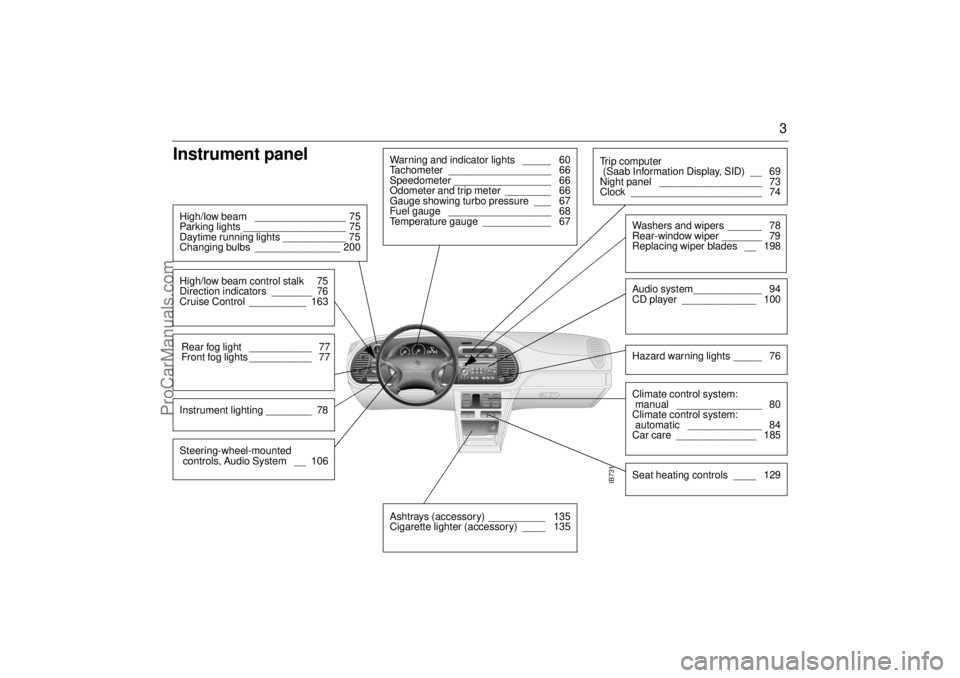
3
Instrument panel High/low beam ________________ 75
Parking lights __________________ 75
Daytime running lights ___________ 75
Changing bulbs _______________ 200High/low beam control stalk 75
Direction indicators _______ 76
Cruise Control __________ 163Rear fog light ___________ 77
Front fog lights ___________ 77Instrument lighting ________ 78
Warning and indicator lights _____ 60
Tachometer __________________ 66
Speedometer _________________ 66
Odometer and trip meter ________ 66
Gauge showing turbo pressure ___ 67
Fuel gauge __________________ 68
Temperature gauge ____________ 67
IB731
Ashtrays (accessory) __________ 135
Cigarette lighter (accessory) ____ 135
Tr i p c o m p u t e r
(Saab Information Display, SID) __ 69
Night panel __________________ 73
Clock _______________________ 74
Washers and wipers ______ 78
Rear-window wiper _______ 79
Replacing wiper blades __ 198Audio system____________ 94
CD player _____________ 100Hazard warning lights _____ 76Climate control system:
manual _______________ 80
Climate control system:
automatic _____________ 84
Car care ______________ 185Seat heating controls ____ 129
Steering-wheel-mounted
controls, Audio System __ 106
ProCarManuals.com
Page 59 of 256
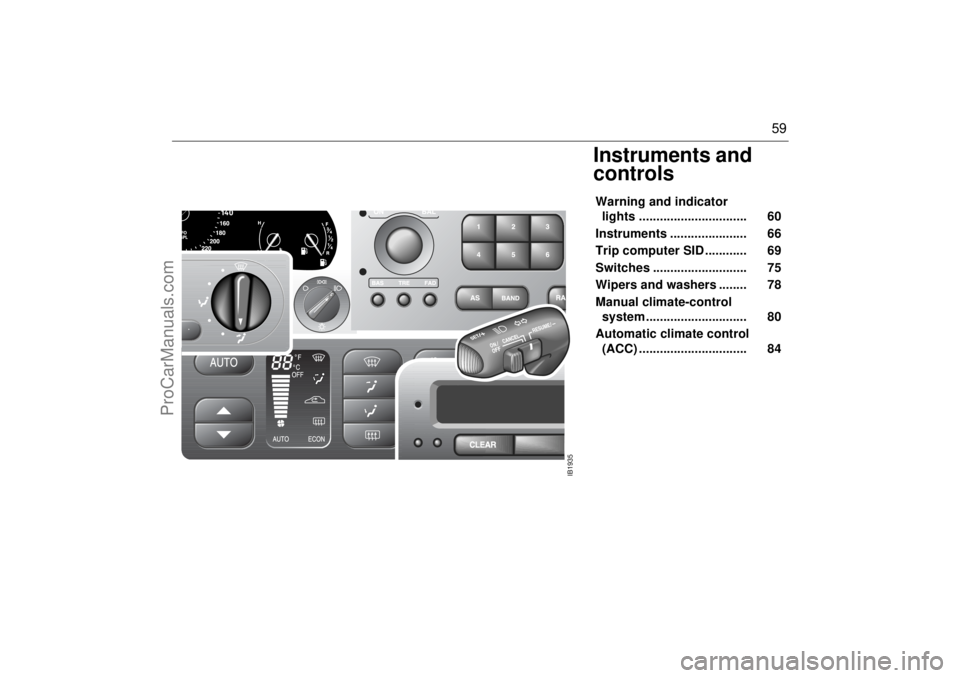
59
Instruments and
controlsWarning and indicator
lights ............................... 60
Instruments ...................... 66
Trip computer SID ............ 69
Switches ........................... 75
Wipers and washers ........ 78
Manual climate-control
system ............................. 80
Automatic climate control
(ACC) ............................... 84
IB1935
ProCarManuals.com
Page 80 of 256
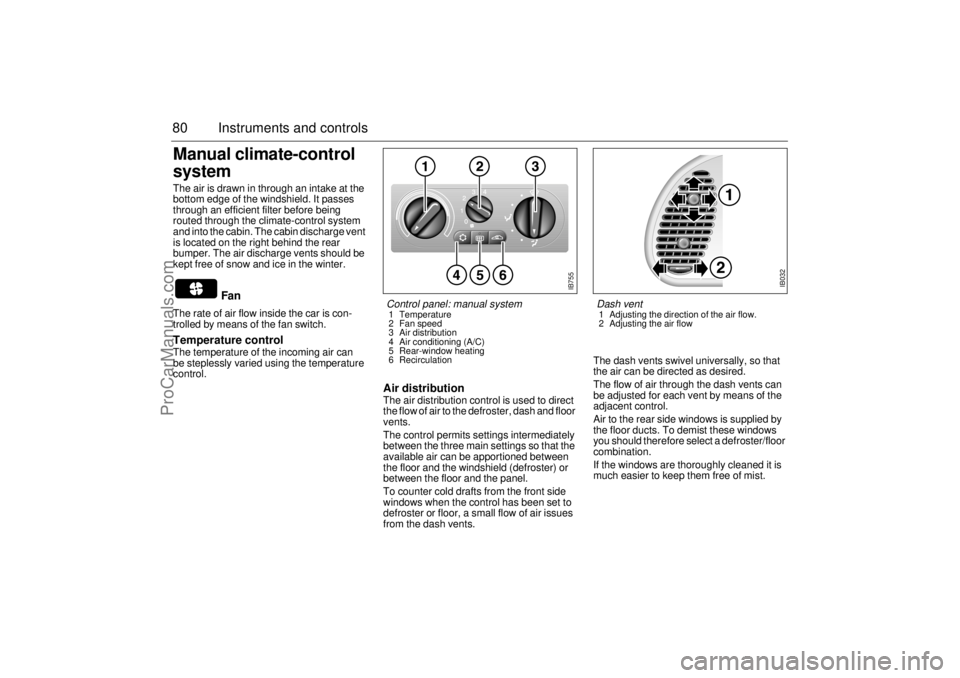
80 Instruments and controlsManual climate-control
systemThe air is drawn in through an intake at the
bottom edge of the windshield. It passes
through an efficient filter before being
routed through the climate-control system
and into the cabin. The cabin discharge vent
is located on the right behind the rear
bumper. The air discharge vents should be
kept free of snow and ice in the winter.
The rate of air flow inside the car is con-
trolled by means of the fan switch. Temperature control The temperature of the incoming air can
be steplessly varied using the temperature
control.
Air distribution The air distribution control is used to direct
the flow of air to the defroster, dash and floor
vents.
The control permits settings intermediately
between the three main settings so that the
available air can be apportioned between
the floor and the windshield (defroster) or
between the floor and the panel.
To counter cold drafts from the front side
windows when the control has been set to
defroster or floor, a small flow of air issues
from the dash vents. The dash vents swivel universally, so that
the air can be directed as desired.
The flow of air through the dash vents can
be adjusted for each vent by means of the
adjacent control.
Air to the rear side windows is supplied by
the floor ducts. To demist these windows
you should therefore select a defroster/floor
combination.
If the windows are thoroughly cleaned it is
much easier to keep them free of mist.
Fan
IB755
Control panel: manual system 1 Temperature
2 Fan speed
3 Air distribution
4 Air conditioning (A/C)
5 Rear-window heating
6 Recirculation
IB032
Dash vent 1 Adjusting the direction of the air flow.
2 Adjusting the air flow
ProCarManuals.com
Page 82 of 256
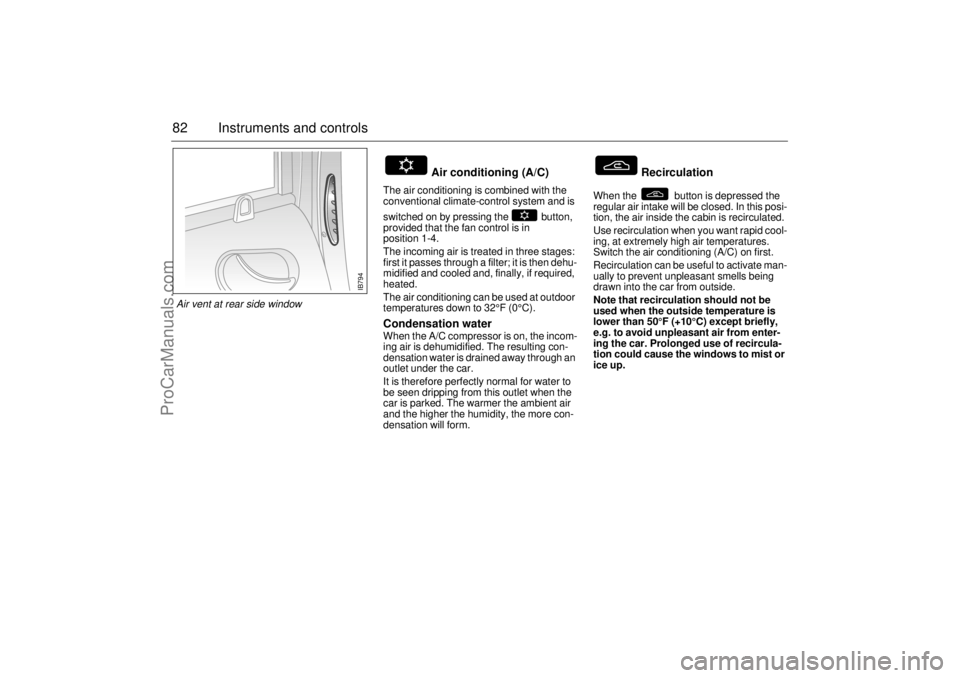
82 Instruments and controls
The air conditioning is combined with the
conventional climate-control system and is
switched on by pressing the button,
provided that the fan control is in
position 1-4.
The incoming air is treated in three stages:
first it passes through a filter; it is then dehu-
midified and cooled and, finally, if required,
heated.
The air conditioning can be used at outdoor
temperatures down to 32°F (0°C). Condensation water When the A/C compressor is on, the incom-
ing air is dehumidified. The resulting con-
densation water is drained away through an
outlet under the car.
It is therefore perfectly normal for water to
be seen dripping from this outlet when the
car is parked. The warmer the ambient air
and the higher the humidity, the more con-
densation will form. When the button is depressed the
regular air intake will be closed. In this posi-
tion, the air inside the cabin is recirculated.
Use recirculation when you want rapid cool-
ing, at extremely high air temperatures.
Switch the air conditioning (A/C) on first.
Recirculation can be useful to activate man-
ually to prevent unpleasant smells being
drawn into the car from outside.
Note that recirculation should not be
used when the outside temperature is
lower than 50°F (+10°C) except briefly,
e.g. to avoid unpleasant air from enter-
ing the car. Prolonged use of recircula-
tion could cause the windows to mist or
ice up.
Air conditioning (A/C)
Recirculation
IB794
Air vent at rear side window
ProCarManuals.com
Page 83 of 256

83 Instruments and controls
The button is located on the climate-control
panel. An LED in the button is lit as long as
heating is on.
Switch off the heating as soon as the rear
window is clear. It will go off automatically
after about 10 minutes.
If the battery voltage is lower than 12 V the
heating will be switched off earlier so that
the battery can get the benefit of the alterna-
tor charge.
Avoid placing sharp objects on the rear
parcel shelf; the heater elements may suffer
damage if such objects touch the rear win-
dow. Do not switch the heating on until you
have started the engine.
Recommended settings in
severe cold On starting with a cold engine, set the fan
switch to position 2 and select defrost to
heat the cabin and defrost the windshield as
quickly as possible.
When the engine is warm enough for the
reading of the temperature gauge to start
rising, fan setting 3 may be chosen. Once
the windshield is clear, the air-distribution
control should be shifted two steps to the
left.
The warm-up time of the engine depends on
the kind of driving. Town driving in high gear
with a low RPM requires a longer warm-up
time than highway driving with a higher
RPM.
Do not use position 4 on the fan switch, as
this is mainly intended to provide rapid cool-
ing in hot weather.
Fault diagnosis and care of A/C sys-
tem, see page 226. Electrically heated rear
window/external mirrors
ProCarManuals.com
Page 84 of 256

84 Instruments and controlsAutomatic climate
control (ACC)The air is drawn in through an intake at the
bottom edge of the windshield. It passes
through an efficient filter before being
routed through the climate-control system
and into the cabin. The cabin discharge vent
is located on the right behind the rear
bumper. The air discharge vents should be
kept free of snow and ice in the winter.
ACC (Automatic Climate Control) automati-
cally maintains the desired cabin tempera-
ture, regardless of the weather outside.
The system will achieve the desired temper-
ature in the quickest possible way.
Note that heating or cooling is not
speeded up by setting the temperature
higher or lower than you really want.
For the ACC system to be most effective, all
windows, and the sunroof if there is one,
must be closed, and the panel vents must
be open.
The incoming air is treated in three stages:
first it passes through a filter; it is then dehu-
midified and cooled and, finally, if required,
heated. The temperature interval within which you
can make adjustments is 58-82°F
(15-27°C). Outside it, there is the HI position
(max. heat and high fan speed) and the LO
position (max. cooling and max. fan speed).
The displayed temperature is not the actual
temperature but corresponds to the comfort
level normally experienced at that tempera-
ture after allowance has been made for the
air flow, relative humidity, solar radiation,
etc., currently prevailing inside the car.
The most usual temperature setting is
66-74°F (19-23°C), depending on per-
sonal preference and what clothing is
worn. It is recommended that changes in the
temperature setting be made in steps of
2°F (1°C).
Conversion between °C and °F is done in
the SID unit; see ”Units and language ver-
sions”, page 74.
During the cooling phase in warm
weather the panel vents must be open.
Do not manually select recirculation in
cold/wintery weather. The reduced air
flow can cause misting and ice on the
inside of the windows.
IB794
Air vent at rear side window
IB032
Dash vent 1 Adjusting the direction of the air flow.
2 Adjusting the air flow
ProCarManuals.com
Page 89 of 256
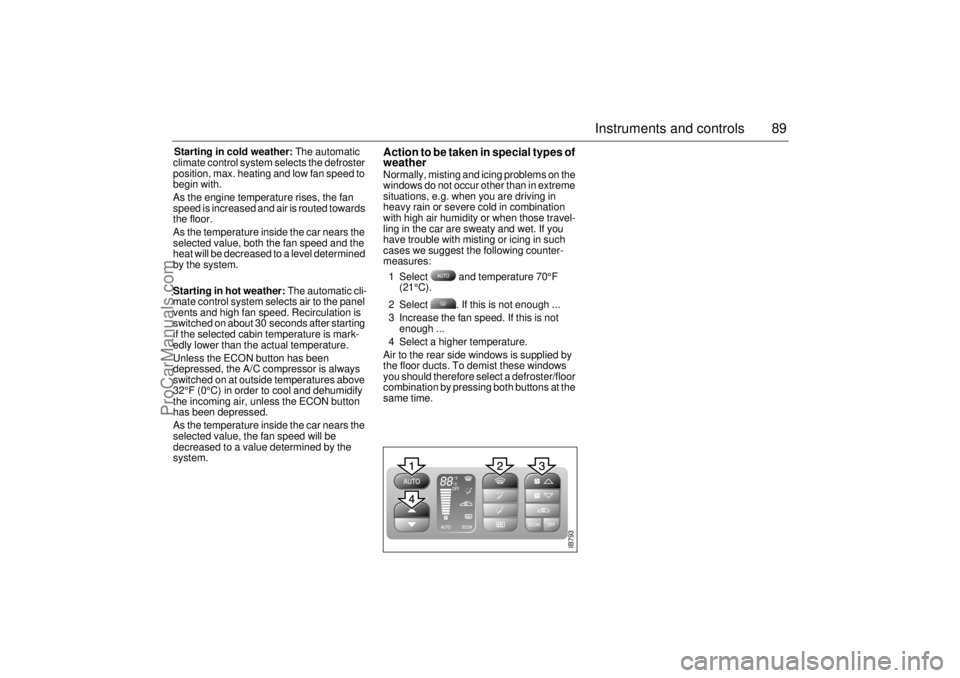
89 Instruments and controls
Starting in cold weather: The automatic
climate control system selects the defroster
position, max. heating and low fan speed to
begin with.
As the engine temperature rises, the fan
speed is increased and air is routed towards
the floor.
As the temperature inside the car nears the
selected value, both the fan speed and the
heat will be decreased to a level determined
by the system.
Starting in hot weather: The automatic cli-
mate control system selects air to the panel
vents and high fan speed. Recirculation is
switched on about 30 seconds after starting
if the selected cabin temperature is mark-
edly lower than the actual temperature.
Unless the ECON button has been
depressed, the A/C compressor is always
switched on at outside temperatures above
32°F (0°C) in order to cool and dehumidify
the incoming air, unless the ECON button
has been depressed.
As the temperature inside the car nears the
selected value, the fan speed will be
decreased to a value determined by the
system.
Action to be taken in special types of
weather Normally, misting and icing problems on the
windows do not occur other than in extreme
situations, e.g. when you are driving in
heavy rain or severe cold in combination
with high air humidity or when those travel-
ling in the car are sweaty and wet. If you
have trouble with misting or icing in such
cases we suggest the following counter-
measures:
1 Select and temperature 70°F
(21°C).
2 Select . If this is not enough ...
3 Increase the fan speed. If this is not
enough ...
4 Select a higher temperature.
Air to the rear side windows is supplied by
the floor ducts. To demist these windows
you should therefore select a defroster/floor
combination by pressing both buttons at the
same time.
IB793
ProCarManuals.com
Page 213 of 256
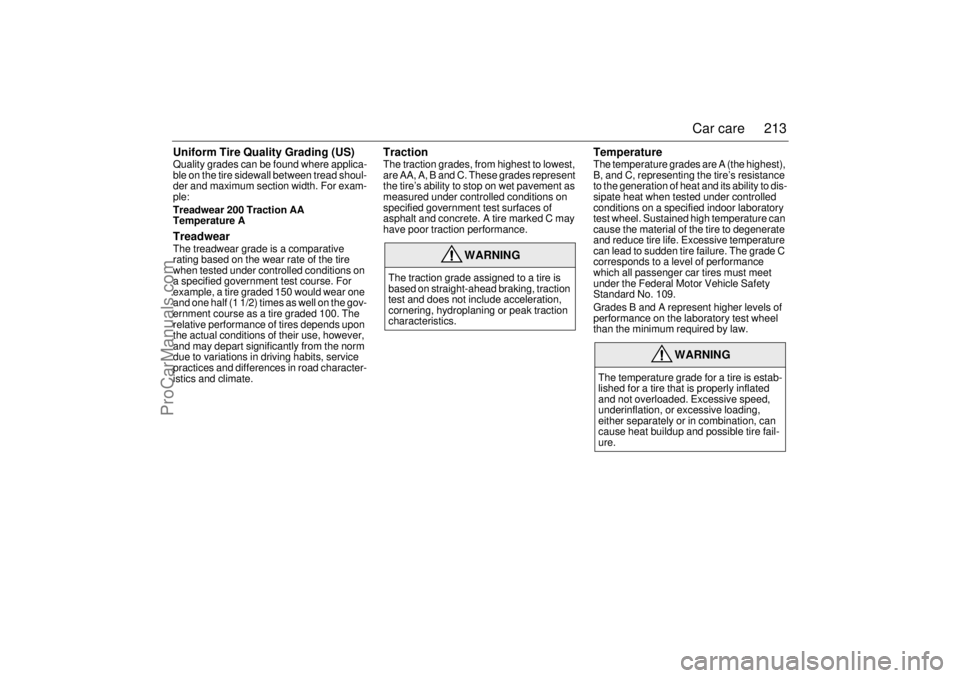
213 Car care
Uniform Tire Quality Grading (US)Quality grades can be found where applica-
ble on the tire sidewall between tread shoul-
der and maximum section width. For exam-
ple:
Treadwear 200 Traction AA
Temperature ATreadwearThe treadwear grade is a comparative
rating based on the wear rate of the tire
when tested under controlled conditions on
a specified government test course. For
example, a tire graded 150 would wear one
and one half (1 1/2) times as well on the gov-
ernment course as a tire graded 100. The
relative performance of tires depends upon
the actual conditions of their use, however,
and may depart significantly from the norm
due to variations in driving habits, service
practices and differences in road character-
istics and climate.
TractionThe traction grades, from highest to lowest,
are AA, A, B and C. These grades represent
the tire’s ability to stop on wet pavement as
measured under controlled conditions on
specified government test surfaces of
asphalt and concrete. A tire marked C may
have poor traction performance.
TemperatureThe temperature grades are A (the highest),
B, and C, representing the tire’s resistance
to the generation of heat and its ability to dis-
sipate heat when tested under controlled
conditions on a specified indoor laboratory
test wheel. Sustained high temperature can
cause the material of the tire to degenerate
and reduce tire life. Excessive temperature
can lead to sudden tire failure. The grade C
corresponds to a level of performance
which all passenger car tires must meet
under the Federal Motor Vehicle Safety
Standard No. 109.
Grades B and A represent higher levels of
performance on the laboratory test wheel
than the minimum required by law.
WARNING
The traction grade assigned to a tire is
based on straight-ahead braking, traction
test and does not include acceleration,
cornering, hydroplaning or peak traction
characteristics.
WARNING
The temperature grade for a tire is estab-
lished for a tire that is properly inflated
and not overloaded. Excessive speed,
underinflation, or excessive loading,
either separately or in combination, can
cause heat buildup and possible tire fail-
ure.
ProCarManuals.com
Page 245 of 256

245 Technical data
Several of the systems in your Saab
car may be adjusted to better fit your
individual needsSome functions are governed by legal
requirements and cannot therefore be
reprogrammed.
Consult an authorized Saab dealer for fur-
ther information.
Car alarm/central locking system:
The level of the siren when locking/
unlocking, HIGH or LOW.
The number of blinks when locking/
unlocking, 1 to 7.
Automatic locking of the trunk when the
car is driven, 1 to 8 mph (2-14 km/h), YES
or NO.
Preclude the unlocking of the trunk while
the car is driven, YES or NO.
Automatic locking of the trunk after
1 second-4 minutes if it has not been
opened, YES or NO.
Automatic locking of the trunk when it is
closed, YES or NO.
Automatic locking of all doors when the
car is driven above 7.5 mph (12 km/h),
YES or NO.Saab Information Display (SID):
Outdoor temperature display can be
adjusted.
Miscellaneous:
Select the on-time for heated rear seat.
Coolant temperature gauge adjustment
can be increased/decreased.
Fuel level gauge adjustment can be
increased/decreased.
Additional sweep of the wipers after wind-
shield washer function (ON or OFF).
Courtesy Headlight Feature (follow-me
home) on-time can vary from 20 to
50 seconds.
Night panel illumination deactivation
speed for the speedometer can be
adjusted.
Following adjustments can be done
by the driver:Automatic Climate Control (ACC):
To alter the preprogrammed “AUTO“ start
up mode with your own preferences you can
manually select the desired settings for:
Temperature.
Fan speed.
Air distribution.
See “Programming I” on page 90 and “Pro-
gramming II” on page 91.
ProCarManuals.com
Page 247 of 256

247 Index
IndexAA/C system, fault diagnosis
________ 226
A/C system, maintenance _________ 226
ACC
__________________________ 84
ACC, useful tips
_________________ 92
Adjustment, steering wheel
________ 131
Air conditioning (A/C), fault diagnosis
and maintenance
______________ 226
Airbag
_________________________ 28
Alarm __________________________ 41
Alarm functions
__________________ 44
Alarm signals
___________________ 44
Anti-corrosion treatment
__________ 222
Anti-theft system
_________________ 41
Ashtray
_______________________ 135
Audio System
___________________ 93
Automatic climate control (ACC)
_____ 84
Automatic transmission
___________ 156
BBattery
________________________ 195
Boost starting from donor battery
___ 181
Brake fluid, check
_______________ 194
Brake fluid, grade _______________ 241
Brake pad wear indicators
___ 164
, 194
Brakes
________________________ 164Braking
_______________________164
Bulb table _____________________205
CCD changer
____________________102
CD player
_____________________100
CHECK messages
_______________72
CHECKING
_____________________72
Cabin lighting __________________133
Calibration, ACC _________________90
Car alarm
______________________41
Care of safety belts
______________218
Central locking
__________________36
Change of address notification
_____232
Changing a wheel
_______________215
Changing bulbs
_________________200
Changing the engine oil
__________190
Changing the key battery __________39
Changing the wheels round _______212
Changing wiper blades
___________198
Chassis number
________________243
Child car seats
__________________19
Child safety
_____________________19
Child safety locks, rear doors
_______39
Child seats
_____________________19
Cigar lighter ____________________135
Cleaning the soft top, Convertible
____57
Climate-control system, manual
_____80
Compact spare wheel
____________214
Condensation water, A/C __________82Condensation water, ACC
_________ 85
Convertible
____________________ 47
Coolant
______________________ 192
Courtesy Headlight Feature
_______ 76
Cruise Control
_________________ 163
Cup holder
____________________ 134
DDICE/TWICE
__________________ 207
Date code, tires ________________ 214
Dim low beam
__________________ 75
Dimmer
_______________________ 78
Direction indicators
______________ 76
Direction-indicator stalk
___________ 76
Dome lighting
_________________ 133
Door mirrors
__________________ 137
Drive belt
_____________________ 197
Driving in deep water
____________ 179
Driving in hot weather ___________ 173
Driving technique
_______________ 170
Driving with a compact spare wheel
184
Driving with a load
______________ 178
Driving with a roof load
__________ 176
Driving with the trunk lid open
_____ 179
EEconomical motoring
____________ 170
Electrical system, technical data
___ 240
Electrical window
_______________ 130
ProCarManuals.com